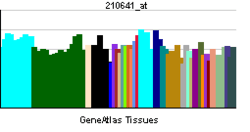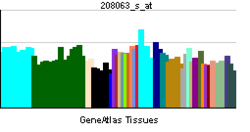CAPN9
| Calpain 9 | |||||||||||||
|---|---|---|---|---|---|---|---|---|---|---|---|---|---|
 PDB rendering based on 1ziv. | |||||||||||||
| |||||||||||||
| Identifiers | |||||||||||||
| Symbols | CAPN9 ; GC36; nCL-4 | ||||||||||||
| External IDs | OMIM: 606401 MGI: 1920897 HomoloGene: 38208 GeneCards: CAPN9 Gene | ||||||||||||
| EC number | 3.4.22.- | ||||||||||||
| |||||||||||||
| RNA expression pattern | |||||||||||||
 | |||||||||||||
 | |||||||||||||
| More reference expression data | |||||||||||||
| Orthologs | |||||||||||||
| Species | Human | Mouse | |||||||||||
| Entrez | 10753 | 73647 | |||||||||||
| Ensembl | ENSG00000135773 | ENSMUSG00000031981 | |||||||||||
| UniProt | O14815 | Q9D805 | |||||||||||
| RefSeq (mRNA) | NM_006615 | NM_023709 | |||||||||||
| RefSeq (protein) | NP_006606 | NP_076198 | |||||||||||
| Location (UCSC) | Chr 1: 230.88 – 230.94 Mb | Chr 8: 124.58 – 124.62 Mb | |||||||||||
| PubMed search | |||||||||||||
Calpain-9 is a protein that in humans is encoded by the CAPN9 gene.[1][2][3]
Calpains are ubiquitous, well-conserved family of calcium-dependent, cysteine proteases. The calpain proteins are heterodimers consisting of an invariant small subunit and variable large subunits. The large subunit possesses a cysteine protease domain, and both subunits possess calcium-binding domains. Calpains have been implicated in neurodegenerative processes, as their activation can be triggered by calcium influx and oxidative stress. The protein encoded by this gene is expressed predominantly in stomach and small intestine and may have specialized functions in the digestive tract. This gene is thought to be associated with gastric cancer. Multiple alternatively spliced transcript variants encoding different isoforms have been found for this gene.[3]
References
- ↑ Lee HJ, Sorimachi H, Jeong SY, Ishiura S, Suzuki K (May 1998). "Molecular cloning and characterization of a novel tissue-specific calpain predominantly expressed in the digestive tract". Biol Chem 379 (2): 175–184. doi:10.1515/bchm.1998.379.2.175. PMID 9524069.
- ↑ Yoshikawa Y, Mukai H, Hino F, Asada K, Kato I (Jul 2000). "Isolation of two novel genes, down-regulated in gastric cancer". Jpn J Cancer Res 91 (5): 459–63. doi:10.1111/j.1349-7006.2000.tb00967.x. PMID 10835488.
- ↑ 3.0 3.1 "Entrez Gene: CAPN9 calpain 9".
Further reading
- Huang Y, Wang KK (2001). "The calpain family and human disease". Trends in molecular medicine 7 (8): 355–362. doi:10.1016/S1471-4914(01)02049-4. PMID 11516996.
- Suzuki K; Sorimachi H; Yoshizawa T et al. (1996). "Calpain: novel family members, activation, and physiologic function". Biol. Chem. Hoppe-Seyler 376 (9): 523–9. PMID 8561910.
- Davis TL; Walker JR; Finerty PJ et al. (2007). "The crystal structures of human calpains 1 and 9 imply diverse mechanisms of action and auto-inhibition". J. Mol. Biol. 366 (1): 216–229. doi:10.1016/j.jmb.2006.11.037. PMID 17157313.
- Strausberg RL; Feingold EA; Grouse LH et al. (2003). "Generation and initial analysis of more than 15,000 full-length human and mouse cDNA sequences". Proc. Natl. Acad. Sci. U.S.A. 99 (26): 16899–16903. doi:10.1073/pnas.242603899. PMC 139241. PMID 12477932.
- Lee HJ; Tomioka S; Kinbara K et al. (1999). "Characterization of a human digestive tract-specific calpain, nCL-4, expressed in the baculovirus system". Arch. Biochem. Biophys. 362 (1): 22–31. doi:10.1006/abbi.1998.1021. PMID 9917325.
External links
| |||||||||||
| |||||||||||||||||||||||||||||

